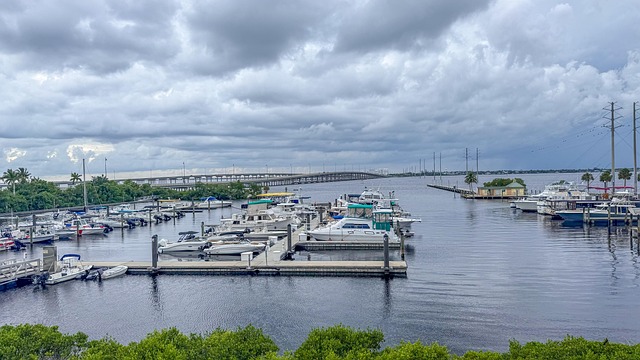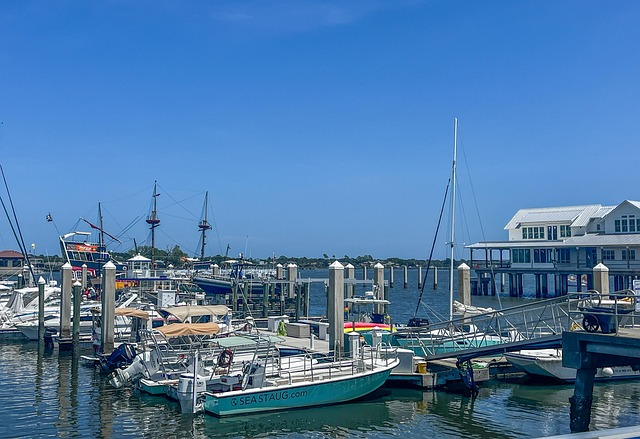Boat Maintenance Costs: How Software Can Help You Save?
Marine operation owners know the boating industry is booming, with $56.7 billion spent annually on boats, engines, accessories, and marina services, including $20.3 billion on new boats alone.
However, managing a marina or boat service facility presents complex challenges that are often underestimated. Unexpected maintenance, regulatory inspections, and overlooked service schedules can quickly escalate operational costs and disrupt the smooth delivery of services.
But what usually drives these inflated costs? The most common issues include vague scheduling, duplicated tasks, miscommunication between teams, missed service windows, and poor parts visibility. The more these pile up, the more they chip away at your margins.

That’s why more marinas, boatyard managers, and boat owners now use technology to reduce waste and tighten up processes. Digital boatyard tools like DockMaster and other boat maintenance software systems offer an integrated way to manage maintenance, track labor, reduce part loss, and gain full control of your operations. Let’s explore how!
The true cost of boat maintenance
When you calculate the real cost of maintenance, you need to look far beyond hourly labor and parts invoices. Unplanned work, inefficient job scheduling, and a reactive mindset often increase expenses without clear visibility into why.
Labor becomes expensive when technicians waste time searching for assignments or repeating work due to poor documentation. Even minor scheduling conflicts create ripple effects that delay everything.
To truly understand what it costs to maintain a boat, consider these hidden and often underestimated factors:
1. Labor inefficiencies
Think about this: how much of their time is being spent working and how much is being wasted waiting or redoing the same task twice? Without a centralized, well-defined plan, they're constantly seeking out their next task or rechecking something they've already done.
And when teams don’t communicate well or have no real-time updates, tasks get lost in the shuffle. That means some jobs get inspected multiple times, and labor costs climb without anyone knowing why.
2. Part mismanagement and boatyard inventory tracking
Ever had to rush-order a part because it wasn’t in stock? Or, find piles of unused parts gathering dust? Poor inventory tracking can cause both headaches.
Without a solid system to keep tabs on parts, marinas end up paying extra for last-minute orders or wasting space and money on parts that just sit around. Plus, when parts get lost or misplaced, your team wastes valuable time searching instead of fixing.
3. Reactive repairs instead of preventive maintenance
Emergency repairs often come with overtime costs, rushed shipping, and extra dock fees. This firefighting approach throws your whole schedule out the window, making it hard for your team to stay on track or deliver consistent quality.
Preventive maintenance might seem like an extra chore, but it’s actually the smarter way to save time, money, and headaches down the road.
4. Impact on customer satisfaction and revenue
Your customers notice when things run late or don’t go smoothly. Slow service turnaround and inconsistent repairs can quickly wear down trust, especially in a tight-knit boating community.
If boat owners can’t count on you, they’ll take their business, and their friends’ business, somewhere else. That means lost revenue, fewer repeat customers, and a tougher time growing your marina’s reputation. Keeping maintenance efficient isn’t just about costs; it’s about keeping customers happy and loyal.

5. Risk of non-compliance and safety hazards
Finally, there’s the serious side of things.
Boats have to meet safety and environmental standards, and skipping inspections or maintenance isn’t just risky, but potentially costly. Fines, legal trouble, or worse, accidents caused by neglected repairs, can have huge financial and reputational impacts.
Staying on top of maintenance schedules and keeping thorough records is essential for protecting lives and your business.
How software helps you save money?
The most effective way to cut costs is to take control of your operations. That means assigning tasks more accurately, tracking service timelines, managing labor better, and avoiding waste. DockMaster gives you that control by streamlining your marine operations with comprehensive solutions.
Here’s how boat management software like DockMaster can help you save time, reduce errors, and boost your bottom line:
A. Work order management
Imagine having one central marina service management software where you can track every customer, vessel, and job without confusion or missed details. With DockMaster’s service management, service writers can speed up quoting by using customizable job templates that ensure accurate pricing and billing. Your technicians get mobile access to their daily tasks, detailed job descriptions, and required parts, plus the ability to log hours and upload photos right from the dock, keeping everyone aligned and work transparent.
Meanwhile, your accounting team benefits from a unified product suite, including built-in accounting that automatically syncs estimates and invoices, making it easier than ever to get paid quickly through email or SMS invoicing and digital payment options.
Because everything is tracked in real time, you can provide customers with updates throughout the job, boosting their confidence and trust. Estimates are clear and detailed, eliminating surprises and allowing flexible quoting whether you charge flat rates or hourly fees. By streamlining your work order management with DockMaster, you reduce costly errors, avoid delays, and create a smooth workflow that saves you time and money while keeping your customers happy.
B. Mobile technician tools
Marine technicians face plenty of challenges, including unexpected issues, changing priorities, and tight schedules. DockMaster Mobile empowers your service technicians with a robust app that keeps them connected and informed in real time. Technicians gain seamless access to job details, flexible time tracking, and the ability to upload photos, videos, and documents directly from the field, all of which sync automatically with DockMaster Desktop.
They can log hours by starting timers or entering totals manually, with time entries linked to specific work order tasks. Visual attachments captured on-site provide immediate evidence to office staff, reducing delays and guesswork. Voice-to-text notes enable technicians to add important details without interrupting their workflow. The interactive mobile scheduler provides real-time updates and color-coded status indicators, enabling techs to manage their daily tasks efficiently.
Plus, quick access to service histories and parts inventories equips your team to complete jobs accurately and efficiently the first time.
C. Preventive maintenance scheduling
Keeping boats in top shape means staying ahead of problems before they happen. But trying to track preventive maintenance manually? Missed or delayed tasks lead to costly breakdowns, safety risks, and unhappy customers, all things no marina wants.
With smart preventive maintenance for boats, you can automate those crucial tasks so nothing slips through the cracks. This not only helps extend the life of your equipment but also slashes repair costs and keeps downtime to a minimum. By staying proactive, you protect your customers, your business, and your bottom line.

D. Inventory management
When parts or fuel run low unexpectedly, it can halt your entire operation. DockMaster’s inventory management system optimizes ordering, receiving, and tracking, all integrated with accounts payable for smooth purchase order handling. You can set minimum and maximum stock levels, monitor parts details, and get real-time updates to avoid shortages or excess inventory.
Built-in reporting tools alert you to low stock and provide insights on inventory value and movement. Barcode generation and label printing simplify tracking, reducing errors. Plus, seamless integration with parts catalogs and fuel management systems ensures accurate tracking of parts and fuel usage. Real-time communication features keep your team coordinated, helping you stay efficient and ready for any job without delay.
E. Service history tracking
Managing service records can be a challenge, especially when technicians are out on the water without easy access to past job details. For example, a technician working on a marina in a remote area with no cell service can still clock in, take photos of repairs, and capture job locations using offline mobile access. Once back online, all this information syncs automatically, ensuring nothing is missed.
Marine service history tracking ties into detailed boat information like model, engine type, and customer preferences. This holistic view helps technicians work faster and with greater accuracy. Plus, integrated time clocks and detailed service notes provide a clear audit trail, boosting accountability and compliance.
DockMaster’s Service Manager enhances this process by empowering technicians with tools to view job details, log hours, upload photos, and track parts, all of which are synced in real time. Service writers benefit from customizable job templates and streamlined quoting, while marine owners receive real-time updates on service progress, keeping everyone aligned and eliminating costly miscommunications.
Additionally, DockMaster’s integrated accounting solution and digital payment options further simplifies billing and improves cash flow. This way, boat repair cost management becomes much simpler when you have all the facts at your fingertips.
Real-world cost savings using DockMaster
Companies that use DockMaster report faster service turnarounds, cleaner inventory cycles, and tighter labor controls. They significantly reduce job durations, freeing up bays and staff to handle more work, which directly boosts revenue. They also reduce parts waste by improving visibility into inventory and streamlining ordering, leading to fewer emergency orders and more efficient parts management.
DockMaster users also improve accountability. Each technician has a digital trail of work, which makes billing accurate and disputes easier to resolve. Service managers spot performance issues faster, coach accordingly, and optimize schedules with real data.
Marine service tracking allows teams to see project progress in real-time. That transparency helps managers make better decisions and customers feel more confident in the service they receive.
Add all of that up, and you’re looking at a much more cost-effective marine operations model.
Getting started with maintenance automation
Still searching through email chains to find work order updates? Or relying on memory and handwritten notes to track maintenance tasks?
These inefficiencies slow your team down and make mistakes more likely. Maintenance automation solves this by giving you structure, clarity, and control, without overhauling everything at once.
Here’s how to get started:
-
Audit your current workflow: Review how tasks are currently scheduled, assigned, and completed. Look for bottlenecks, miscommunications, and repetitive manual steps that could be streamlined or eliminated
-
Digitize your records: Centralize job logs, customer profiles, parts usage, technician notes, and billing history into one digital system. This ensures everyone on your team has access to accurate, up-to-date information, anytime, from anywhere
-
Train your team: Focus on showing real value to each role. For example, how techs can log hours with one tap, or how service managers can approve jobs faster. When people see how it makes their work easier, adoption happens naturally
-
Evaluate the right platform: Look for tools like DockMaster that centralize scheduling, work orders, parts inventory, billing, and customer communication. Choose a system that integrates with your workflows, not one that forces you to rebuild them from scratch
Know the real cost of maintenance, then take control
Boat maintenance costs can vary significantly based on size, usage, environment, and service frequency. Whether you manage a marina, run a boatyard, or own a boat, one thing is always true: unplanned maintenance adds up fast. Without a clear system in place, even routine upkeep can become a drain on time, money, and resources.
DockMaster is designed to help you streamline maintenance workflows, track labor and parts with precision, and keep every detail organized in one place. From scheduling service jobs to managing inventory and handling customer communication, DockMaster provides the clarity and control your operation needs.
When you have a full view of what’s happening and what’s due, you can prevent waste, avoid delays, and confidently manage your maintenance costs. Request a demo and take control of your marina today.
